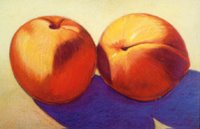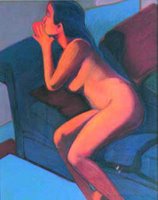Pastel Painting

Traditional soft pastels are one of those mediums that most non-artists do not understand. At least, they don’t understand them very well. For a very long time pastels were not seen as something that was used for doing serious work. It was considered a medium that was used for doing preparatory work for the real painting, i.e. an oil painting. Or it was seen as a medium that one might take with them when going off to do some sketching. As a young artist I pretty much had that same opinion.
About twenty years ago I started using pastels again after not touched them for a very long time. Because my children were young and trying to take care of them and work with oils was impossible for me, I gave up painting. I either did photography or worked on pen and ink drawings. This was fine for a while but I have always loved color and missed using it. I tried using colored pencils but just didn’t like the results that I was getting. I also wanted to be able to cover larger areas and to be able to work quickly. Young children kept me from spending too much time focusing on my paintings. Pastels seemed like the right choice. Open the box and be ready to work. Clean up was basically closing the box and cleaning my hands with diaper wipes. Pretty simple. So I bought a cheap set of 24 colors and starting working.
 I absolutely hated them! As a painter I was used to mixing any color that I wanted. Squeeze 2 or 3 colors on a palette, mix them and I have the color that I wanted. With the pastels, I couldn’t just mix 2 or 3 sticks together and get the right color. I could blend the colors on the surface but then I would get smooth and flat areas, which I did not like. I was after a much more sketchy look, something that was controlled but had a very casual feel to it. I would spend hours looking at pastels by Edgar Degas, Mary Cassat, and Wayne Thiebaud trying to figure out how they achieved their results. I swore that once I learned how to use them properly I was going to throw them away and never touch them again. Well, I learned how to use them and then used them exclusively for 10 years.
I absolutely hated them! As a painter I was used to mixing any color that I wanted. Squeeze 2 or 3 colors on a palette, mix them and I have the color that I wanted. With the pastels, I couldn’t just mix 2 or 3 sticks together and get the right color. I could blend the colors on the surface but then I would get smooth and flat areas, which I did not like. I was after a much more sketchy look, something that was controlled but had a very casual feel to it. I would spend hours looking at pastels by Edgar Degas, Mary Cassat, and Wayne Thiebaud trying to figure out how they achieved their results. I swore that once I learned how to use them properly I was going to throw them away and never touch them again. Well, I learned how to use them and then used them exclusively for 10 years.
Pastels combined everything that I liked about both drawing and painting. I had always liked drawing better than painting and this gave me the chance to draw with color. I loved the fact that the medium was always “open” and that I didn’t have to worry about any color shift with drying paints. My studio space was small and it was great that I didn’t have to work about any fumes although the dust was a real pain. Like any other medium though, it had its downsides.
To get the effects I wanted I had to spend a lot of time doing prep work on my paper. I spent more time prepping my sheets than I actually spent painting. If I could’ve afforded to by sanded pastel paper this would not have been an issue. At the time dark colors were really limited so I was never able to get the range of darks that I wanted. Those were minor issues. The real problems came when the work was done.
I only used fixative during the intermediary stages because of the color changes that it caused. I never used fixative after the final layers of color were put down. This meant that I had to be very careful about storing unframed pieces. Framing became another headache. Pastels need to be framed under glass. This means that a mat must be used. To keep the bevels on the mat from getting pastel dust on them, the mat needs to be raised with a floater behind the mat. It is always necessary to use glass. If plexiglas is used, static electricity can pull the pastel away from the support. The glass also means extra weight and care when shipping or transporting the paintings. If I wanted to do anything large it became a nightmare and would cost a small fortune. The largest pastel I did was a 30” X 40” on a masonite panel and I used a spacer to keep the glass off of the surface.
I don’t use my pastels very much anymore but I pull them out every so often and play and experiment with them trying to find ways to overcome their negative aspects. Maybe one day I’ll figure it out. The 2 above pieces are both pastels that I did in the early to mid 1990’s. They are titled “Daydreaming” and “2 Peaches”. Both are done on home made sanded pastel paper that was toned with an acrylic wash. The under paintings were done with hard pastel that I scrubbed in with a wash of turpentine and layered over using soft pastel. There is no fixative on the final layer but in the spirit of Degas, I used steam to set the final layer. Both are matted (with a spacer) and framed under glass.


5 Comments:
Hi Ed
nice to see you posting ... and this is an interesting one as I just love pastels and find that I am far more confident with them than I ever am with acrylics! But have not done any for a year because there seems to be buyer resistance to them, IMO.
These two are really beautiful and you should DO MORE of them! The colours are terrific and the texture is how I like pastels to be .... I like them to look like paintings and this is what I try for.
Luscious, gorgeous, yummy colors. Dang, given the monitor lies and tends to mute things a bit, I wonder how electrifying these would be face to face...
Hi Ed, Glad you've posted again!
Funny, I wrote an almost identical post awhile back about pastels, didn't post it because I needed to get a good shot of the pieces or get the slide images onto the computer but I never got around to either.
Anyway, I started working in pastels for the same reason as you-very easy to pick up and put down with little kids underfoot.
Your pieces are beautiful.
I love the work. I have never tried pastels but I think that I might try now, the clean up factor is very appealing. Great post.
I loved reading your words about pastels. I too enjoy working with them, especially since I have a toddler underfoot, and hate the headache of framing. How do you use steam to fix pastels? I have never heard of this, could you please explain.
Post a Comment
<< Home